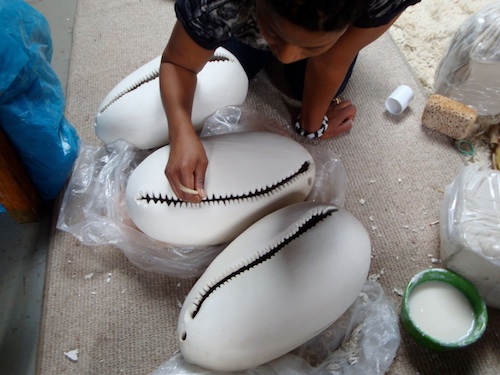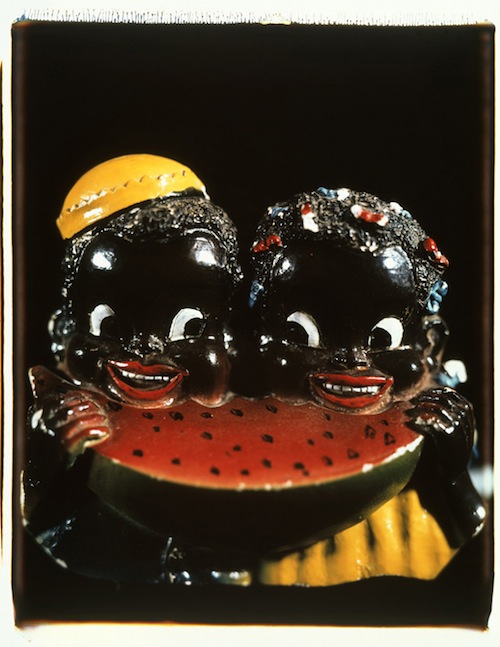
David Levinthal. Untitled from the series Blackface, 1996. 20×24 Polaroid Polacolor ER Land Film, 40 x 33 ½ in (framed). Image via blog.artspace.com.
Watermelon is a leitmotif of Blackface memorabilia that flourished during the late 19th and early 20th centuries. Depictions of African Americans ravenously eating the fruit helped perpetuate the myth of our collective fondness for it; and reinforce ideas of an inferior race, stereotyped as being shiftless and “interested only in such mindless pleasures as a slice of sweet watermelon.” [1] Ceramic knickknacks like the one pictured above are typical in that the fruit wedge mimics the grin of the eaters. It also serves to emphasize their exaggerated red lip-color and darkly-painted skin, features that starkly contrast the whites of their bug-eyes. Sadly, these minstrel caricatures are not the worst of them. Depictions of adult men could be far more grotesque; they were often portrayed as having mouths as big as a watermelon itself. While this kind of imagery is seen less frequently today, it’s certainly not a thing of the past. Google search President Obama and you’ll find plenty.
New York-based artist Simone Leigh had the watermelon stereotype in mind when she began casting molds from the fruit five years ago. From them she has created nearly 100 ceramic forms now installed at The Kitchen in her solo exhibition You Don’t Know Where Her Mouth Has Been. “I could have used any gourd to make molds,” said Leigh. But she saw her sculptures as an opportunity to build a new narrative, to “rewrite the watermelon.” To my surprise, Leigh called the stereotype not disgusting or debasing (as I might have) but of all things “ironic.” Then she explained: watermelon happens to evoke the same language that has been used to negatively brand the black body as “too large, overgrown, fat” and generally “lacking control.” Leigh described the fruit itself as being “kind of preternatural.” At the same time, watermelon is sensual, a so-called aphrodisiac that elicits the words juicy, ripe, and refreshing — expressions often used to compliment or objectify black female bodies. It is in fact how black bodies have been discussed and displayed over time that concerns the artist by and large. [2] To tell you the truth, her work isn’t about food at all.
Leigh’s interests lie not in edible materials but rather in iconography and “forms that people associate with the ethnographic.” Plantains are another example. Molded and cast in blue clay for her sculpture Wedgewood Bucket (2007), Leigh sees the banana-esque fruit as a symbol for the post-colonial. How plantains cook or taste is neither here nor there. The artist’s use of food is marginal for sure but the impact is still profound. As regards watermelon, Leigh’s molds function as receptacles for transference, means of implanting knowledge of the fruit’s racial and racist associations into her objects. In sculpting and building up the shapes, instilling in each her own views and aesthetics, they are totally transformed and offer up new frames of reference. This is exemplified by works such as Queen Bee (2008-2012), currently on view at The Kitchen. The chalky black surfaces of these watermelon-shaped terra cottas allude to early blackface minstrelsy yet the TV antennas that pierce them suggest that this levitating “chandelier” is more of the future than the past. Though Leigh denies having Afrofuturist intentions (as has often been said of her work) she admits to a fondness for “mixing histories” and bringing “recent technologies” to older techniques.
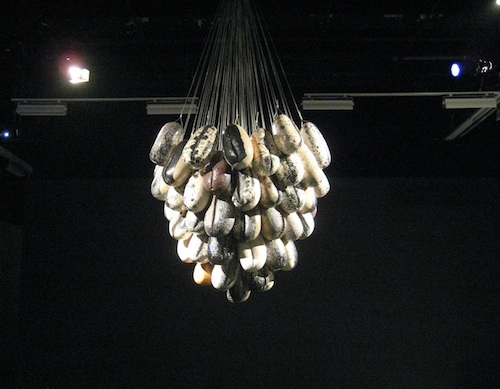
Simone Leigh. "You Don't Know Where Her Mouth Has Been," 2012. Stoneware, porcelain, and wire, dimensions variable. Courtesy the artist, Tilton Gallery, and The Kitchen. Photo: Jenny Blumenfield.
Central to You Don’t Know Where Her Mouth Has Been is the installation of 65 cowrie shells for which the exhibition is named. These too were cast from watermelons. Where a smaller version of this piece wowed viewers at the Studio Museum in Harlem last year, it’s apparent now that the sculptures were just beginning to blossom back then. They are matured and even more breathtaking today. The bulbous parts of this low-hanging, grape-like cluster feel meant to be plucked from their wires. But their toothy ridges can intimidate. Cowrie shells, once treated as money in various parts of the world, can be found today in a craft shop, selling for almost nothing. With her super-sized representations of them, Leigh seems to make a point about the fickleness of value, and perhaps how changing notions of the useful and the decorative are inherent to her own craft-heavy practice.
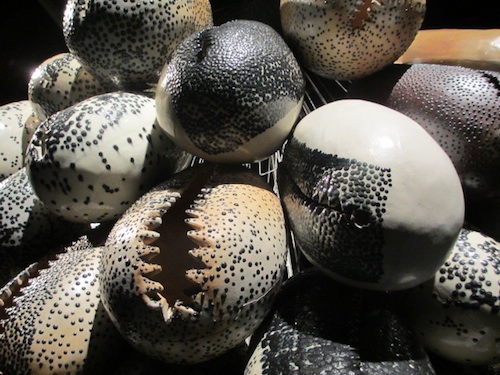
Simone Leigh. "You Don't Know Where Her Mouth Has Been (detail)." Courtesy the artist, Tilton Gallery, and The Kitchen. Photo: Jenny Blumenfield.
No cowrie shell is identical to another. Some bear black dots that, given the artist’s permission to touch, reminded me of the kinks and bumps of my own hair. Others twinkle with bronze-colored wisps and rings, the result of placing copper in the kiln. Blurred patterns and hints of an iridescent orange glaze are attributed to “atmospheric salt firing” wherein common table salt or fleur de sel is literally tossed into the kiln. Here again in Leigh’s material underlies a parallel in history: like cowrie shells, salt was once so precious that is was treated as currency. And then there is this fortuitous metaphor: it’s an old southerner belief that sprinkling salt on a slice of watermelon draws out its sweetness. For Leigh, however, salt raises notions of purity, a falsehood revealed by the mineral itself. “[Natural] salt actually looks dirty,” she says. Born from her recent experiments in the kiln is Kool-Aid, a tightly hung group of salt-filled glass bulbs. Lit from above with red, pink, and blue color gels, the effect is gorgeously psychedelic. With this, Leigh sends a shout out to the forty-year old black arts collective Africobra, whose color palette was, as the title implies, shades of Kool-Aid.
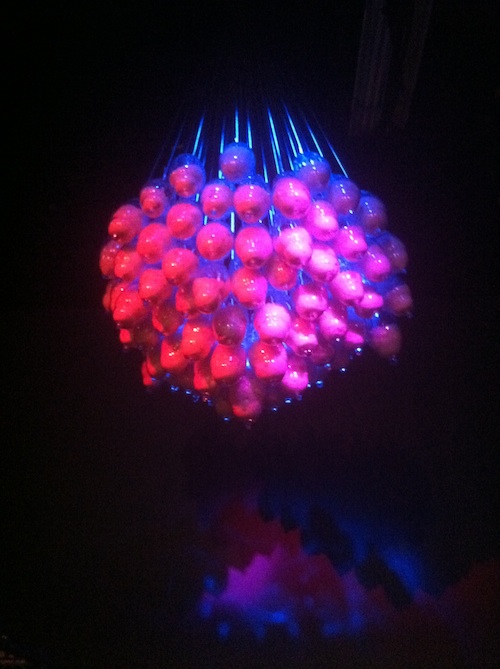
Simone Leigh. "Kool-Aid," 2012. Glass, salt, wire, light, and color gels, dimensions variable. Courtesy the artist, Tilton Gallery, and The Kitchen.
Where the ingenuity of Africobra doesn’t come to mind in this exhibition, the pioneering feminist artist Judy Chicago does. Leigh’s new body of work recalls the premiere of The Dinner Party not merely because of the ceramic medium (though there is that affinity) but in the sense that, in this moment, her objects are audacious beyond compare. Too, Leigh draws on a range of cultural histories, academic discourses, and methods of production to then reject, reclaim, and revise them. Fruits and salts are just some of the tools that help her ideas take shape.
Curated by Rashida Bumbray, Simone Leigh: You Don’t Know Where Her Mouth Has Been is on view through March 11, 2012. A theater performance will be held in conjunction with the exhibition. Click here for more information.

